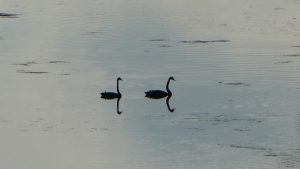To the residents of Clarence County who are interested in modern mining methods.
Ladies and Gentlemen,
In 2019 our exploration efforts have been hindered by the bush-fires and in 2020 by Covid19 Restrictions. So, there has been not very much progress towards production on which I can report. My efforts are still at a very early stage and the information I can provide at this time is still subject to serious additional drilling efforts. This is what I have done so far:
- Clean-up of old tailings from mining activities during the last century:
Environmentally concerned citizens of Ewingar have asked me, whether I could clean-up old tailings that have been left behind by previous miners near the former shafts of a mine-site called “Just-In-Time-Mine”, because they are rightfully worried about acidic mine drainage within the Clarence River Water Catchment. It is my personal opinion that this area is so sensitive to many traditional industrial activities (not only extractive industries) that all future investments in this area must be given very serious attention regarding environmental issues. I have had a chance myself to watch a pair of Black Swans with their siblings in the Clarence River and it is absolutely necessary to protect this beautiful environment for future generations. Therefore, I am using great care in everything I do in exploring for metals in the Drake Volcanics.

I have had assays taken from old ore-piles that should be removed from the environment and have shipped 8 kg of samples to Germany by Air-Mail to do metallurgical testing. From this work I can confirm to you today that the removal of these old ore-piles is planned for 2021. To dispose of these old ore-piles properly we need to haul about 100 truck-loads to a licensed processing facility that is acceptable to the NSW Resources Regulator (RR) and I am currently in touch with the RR to get the necessary approvals. In parallel I am negotiating with established mining-companies to sign a tolling-agreement for the processing of these 100 truck-loads and the proper disposal of the resulting secondary tailings. However I would like to point out that I am not legally obliged to clean up old left-overs from previous mining in the Clarence and that I am doing this voluntarily to build trust in my activities and to be granted a social license to move ahead with other projects that I may have in the future.
Due to very high amounts of unpredictable rainfall in the entire Northern Rivers area I would not apply for a license to start an open-cut mine with associated processing of ores by cyanide leaching behind a tailings dam. The reason being, that I would not like to be responsible for any dam-overflow and the wash-out of cyanide in such a sensitive area. Today there are ore-processing technologies available that employ bacteria to extract copper and thiosulfate to extract gold from ores. These new technologies may be a little bit more expensive than traditional methods. But the extra expense is necessary to avoid serious threats to the environment. I would therefore like to suggest to the CVC that the use of cyanide within the Clarence River Headwaters should be banned. There are better alternatives today that have been pioneered by CSIRO over the last two decades. These environmentally friendly mining method are now ready for use and should be employed in sensitive areas like the Clarence River Catchment.
Risks to the environment from mining can also be reduced by operating only quarries in sensitive areas and hauling the ores to offsite processing sites away from sensitive water catchments. Such quarries are easy to rehabilitate and every miner, who is granted a mining license, has to furnish a bond that can be used to rehabilitate the quarry or mine in case the miner should go out of business before rehabilitation is fully completed.
Mining risk can be minimized even further by developing new mines as underground-operations. In this type of mine all tailings can be left underground today. They are simply shifted a few yards underground as the mining process proceeds. Therefore, this type of a mine is called a “Zero-Waste-Operation.” And because all work is done underground there is no dust above ground level and no open pits that could be washed out by future rainfalls. I believe this type of a mine would not pose any threat to the Clarence Headwaters and would be acceptable to the citizens of Clarence County. Therefore, it is important to me, that the citizens of Clarence County and their Councilmen and Councilwomen understand the differences in traditional open-cut mining with a traditional processing facility behind a tailings dam and an underground zero waste operation that uses bacteria to extract copper instead of dangerous chemicals. This new type of mine has a very small footprint on the surface. All you can see there is a large building. All mining activities happen within that building or underground.
- Magnetic Imaging of the Drake Volcanics
So far, we have focused on exploring the magnetic footprints of ore-deposits within the Drake Volcanics. Today it is technically possible to “look” about 2000 meters down into the earth-crust to discover magnetic anomalies that are commonly associated with ore-deposits. This work is still at an early stage as well. And it is a big difference whether we know from a magnetic image that there is a possible Copper Deposit at a depth of say 200-400 meters or whether we incur the cost of drilling several holes into these possible ore-deposits to recover drill-core and have it assayed.
At this exploration stage I believe that there are two large porphyry-copper deposits to the West of the Clarence River and to the South of Drake. This type of copper deposits usually appears in the form of clusters and there may be more such deposits that I still do not know of. One of these two deposits seem to be underneath the old “Just-In-Time-Mine”. A company by the name of Kambalda Minerals has drilled eight holes in the area 50 years ago down to 100 meters and from the drill-core, they have recovered, I have concluded that there may be a deeper source of Copper hidden underneath the previous drilling. The other large deposit seems to have a diameter of three kilometres and a width of several hundred meters. It is located just outside my initial Exploration License EL8822 and I have therefore applied for an additional Exploration License (ELA6150) to explore this magnetic signature as well. This deposit may contain enough copper to support a stand-alone mining operation. But we won’t know about the metal content until we have drilled several holes into this deposit as well. If grades are high enough these two deposits may justify going on to production. About 60% of the entire worldwide copper production come from this sort of copper-deposits. And in the Drake Volcanics there may be deep copper deposits that are worth several billion Australian Dollars at current prices. And – most likely – they could only be accessed by underground mining and a very small footprint at surface.
If the estimated initial capital investment of about 500 million Australian Dollars for such a mining operation seems to be economically feasible, Clarence County Residents may enjoy much better opportunities for employment after 2030. Currently we could not make such an investment ourselves and would need to grow considerably to handle such an investment.
- Planned exploration activities in 2021
I am a great fan of Phyto mining, which I consider the environmentally friendliest, emerging mining method, available today. We would like to help pioneer the use of plants like gum trees, to extract gold from the ground. It is known by now, that gum trees have deep roots that can extract gold from a depth of down to 100 feet. The extracted gold is accumulated in the leaves. Other shrubs in New Caledonia are known to concentrate nickel. Gold in gum trees or nickel in shrubs can be harvested by burning the wood to generate power. The metals are then extracted from the ashes.
Since these new mining methods are not know very well by the public, I am enclosing a few lines from the “New Phytologist Foundation”:
“More than 40 years since the discovery of the spectacular New Caledonian hyperaccumulator tree Pycnandra acuminata, knowledge on these unusual plants has advanced considerably. Hundreds of other hyperaccumulators of metal and metalloid elements have since been reported, and new discoveries continue to be made at an accelerated pace. The field has matured and is the current subject of detailed investigations into the molecular biology and physiological aspects of the hyperaccumulation phenomenon, as well as research on ecological interactions. Hyperaccumulator plants have also found useful applications in phyto‐extraction technologies, especially in nickel Phyto mining”
My mining companies in Australia, Canada and Germany are committed to the use of Phyto mining wherever possible. This way of mining will allow many farmers and foresters to participate in environmentally friendly mining activities. And it will allow them to generate additional income.
4. Community Consulting in 2021
I hope to be able to travel to NSW again in March of 2021 and will be happy to visit you again in person and to answer any questions you or your councilmen and councilwomen may have.
Kind regards from Bavaria,
Hans-Werner Kummerow

